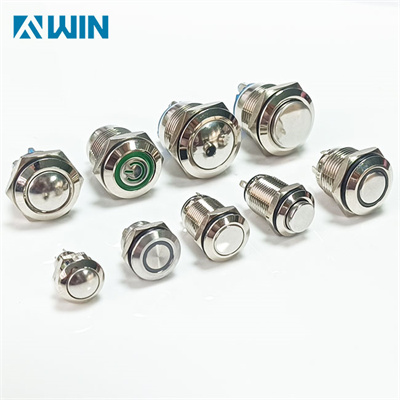KNOWLEDGE
What is the metal push button switch ?
A metal push button switch is a type of electrical switch designed with a metal housing and actuator, engineered for durability, reliability, and resistance to harsh environments. Unlike plastic switches, which are prone to wear, corrosion, or damage from physical impact, metal push button switches are built to withstand heavy use, extreme temperatures, moisture, and mechanical stress, making them ideal for industrial, automotive, aerospace, and outdoor applications.

Key Components
A typical metal push button switch consists of several core parts:
- Metal Housing: Usually made from materials like stainless steel (304 or 316), aluminum, or brass, providing structural strength and corrosion resistance. Stainless steel is preferred for its anti-rust properties in wet or chemical-exposed environments.
- Actuator: The part pressed by the user, often a metal button or lever, available in various shapes (round, square, flat, or convex) and finishes (polished, matte, or textured) for ergonomics and aesthetics.
- Contact Mechanism: Inside the switch, electrical contacts (often silver-plated or gold-plated) open or close a circuit when the actuator is pressed. This mechanism can be momentary (returns to its original position when released) or latching (stays in the pressed position until reset).
- Terminals: Connection points for wires, typically screw terminals, solder lugs, or quick-connect tabs, ensuring secure electrical connections.
Functionality
When the actuator is pressed, it triggers the contact mechanism:
- Momentary Switches: Common in applications like emergency stops, doorbells, or machine controls, where the circuit is only active while the button is held.
- Latching Switches: Used for power on/off functions, where pressing once completes the circuit, and pressing again breaks it (e.g., industrial equipment power buttons).
Advantages
- Durability: Metal construction resists impact, vibration, and abrasion, with a long service life (often up to 1 million operations).
- Environmental Resistance: Many models are IP-rated (e.g., IP65, IP67) for water and dust protection, suitable for outdoor use or dirty industrial settings.
- Temperature Tolerance: They operate reliably in extreme temperatures, from -40°C to 120°C, unlike plastic switches that may warp or crack.
- Safety: Metal housings can be grounded to prevent electrical hazards, and some are designed to resist explosion or fire, critical in hazardous areas.
Applications
Metal push button switches are widely used in:
- Industrial machinery (conveyors, presses, assembly lines)
- Automotive and marine controls (dashboard switches, winch controls)
- Aerospace systems (cockpit instruments)
- Outdoor equipment (streetlights, security gates)
- Medical devices (equipment power controls)
- Public infrastructure (emergency call buttons, transit station controls)
In summary, metal push button switches combine robust construction with versatile functionality, making them indispensable in scenarios where reliability and longevity under tough conditions are paramount.
Column navigation
NEWS
CONTACT ME
CONTACT:
Skype:evelynhwang2013
phone:15999819066
E-mail:fvwin@fvwin.com
ADD:NO.168,Technology East Road,Shijie Town,Dongguan,GD,CN